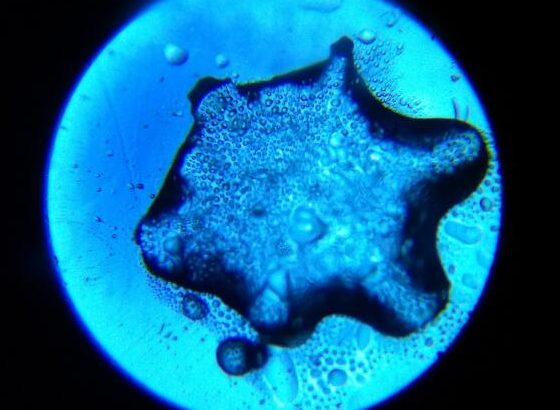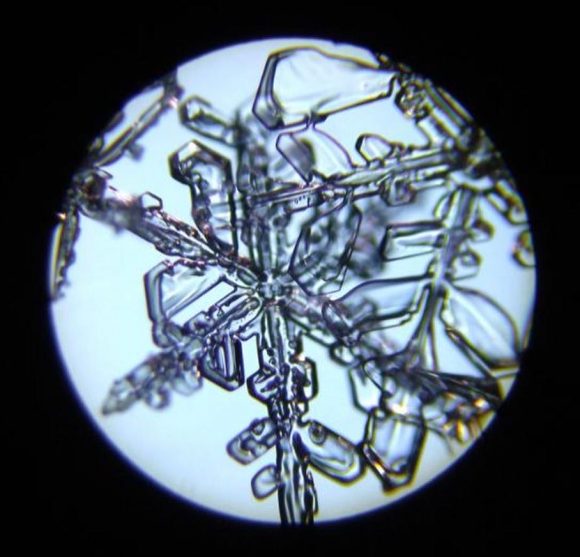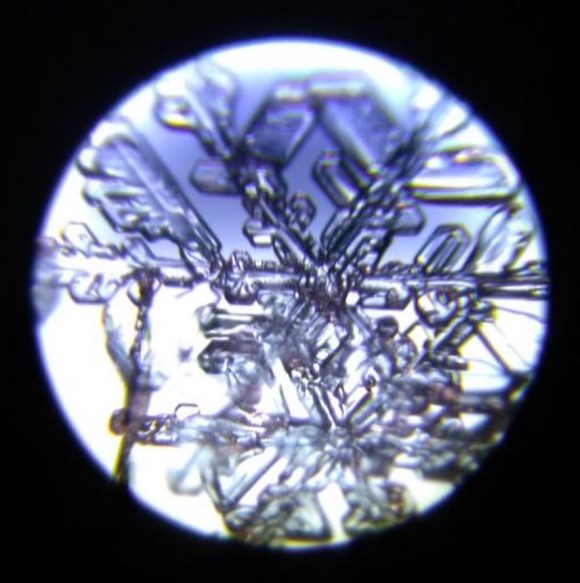
Lessons from Snowflakes Persistence and Curiosity in the Classroom
February 23, 2022
A few weeks ago my son (who lives far away in a snowy valley of northern Utah) texted me this picture:
It’s a photo he’d taken of a partially-melted snowflake under a microscope. He told me that it was harder than he thought to capture the flakes under magnification, that all of the equipment he was using and even his own body heat as he interacted with the slides were prone to melting the flake before he could snap a photo. This was his best try at trying to catch it before it could melt.
Despite its imperfection, I printed this out and posted it in my home office workspace as a reminder of how hard it can be to achieve a perfect outcome, and yet how beautiful the learning process can be.
At the time I was thinking a lot about fostering curiosity and persistence in my students–I wanted them to learn the pleasure of the research process and of ongoing iteration, editing, and polishing their expression of that research. I’d observed that many of my students turned in research essays that seemed more like first drafts of their ideas than a well-honed expression of their efforts. To aid them in this process I developed a “Recipe for a Successful Student Essay,” which I hoped would give them a framework for the writing process and would lead them through the steps that would set them up for a successful expression of their work. Since using the “Recipe” formula with my students, I’ve observed that their essays tend to better adhere to the assignment requirements, are better edited, and are more likely to be turned in on time.
Just a few days ago, my son sent me some new photos of his efforts with snowflakes. These more recent images were far more clear and crisp. In fact I gasped as I scrolled through these and marveled at the intricacies of snowflakes: so much depth and beauty in such a small frame. I was proud of my son for making progress on his process, and of being able to capture the awe-inspiring crystal details of each flake:
I also admired his persistence at sticking with his goal and determining all the steps he needed to take in order to get clearer non-melty photos. Each time I look at these I imagine him trying and trying and trying again, and the triumph he must have felt when finally getting some clear images. Of course they aren’t perfect, so I suspect he will be trying again and I will get even better images, and I am eager to see how those will turn out!
Like my son I am continually iterating and improving, especially when it comes to teaching. To that end, I share some of my recent teaching-related finds with you:*
- I’m participating in the IETL’s year-long Open Educational Resources initiative, because research shows that OERs significantly enhance student success. It’s not too late to join in, if you would also like to learn more about using OERs in your courses. For those of you who missed our last meeting, I’d encourage you to watch at least the first 10 minutes of this recording of that event, where our new VP, Dr. Reginald Chhen Stuart, discusses how OERs enhance DEI efforts in HigherEd
- Want to add your name pronunciation to your email signature? Here’s a quick tutorial for doing so.
- Using the NCFDD framework, I’ve created my personal Strategic Plan, to better balance the effort I put into teaching, scholarship and service. I intend to join their Spring 14-Day Writing Challenge and hope that many of you will join in, too (note: the NCFDD is free for Chapman faculty)
- Did you know that you have access to Grammarly Premium and so do your students? Learn about other software that’s licensed for Chapman faculty on this resource page.
- Something to think about: some students thrived in the pandemic online environment
- Join me at the April 27th, 9-11am, *in-person* workshop with Jose Antonio Bowen on Dealing with Difficult Topics in the Classroom
- Recent Chapman alum Leah Thomas speaks about Intersectional Environmentalism in this video. Watching this has me even more committed to addressing racial justice in my courses and I also can’t wait to get my copy of her book, The Intersectional Environmentalist
- Have you been recording instructional videos for your students? Here’s a short article with tips on improving video quality
- Are you considering midterm teaching evaluations? This resource by Elena Marusak has some good info for you.
In closing, I want to share this quick intro to Open Educational Resources, for those of you who would like to learn more and perhaps join our upcoming OER Happy Hour Events:
*Kudos to Educational Technology staff members for contributing to this list of links






